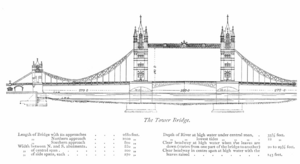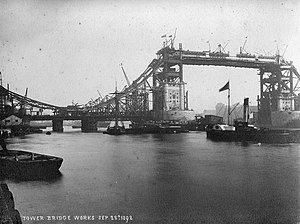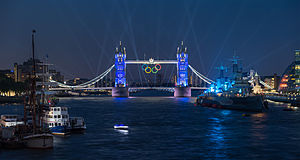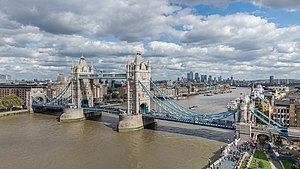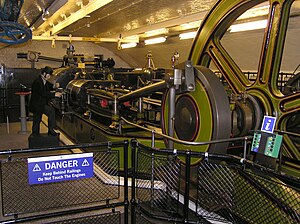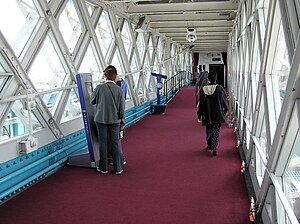Tower Bridge
| Tower Bridge | |
| Middlesex, Surrey | |
|---|---|
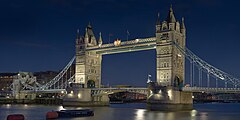
| |
| Location | |
| Carrying: | A100 Tower Bridge Road |
| Crossing: | River Thames |
| Location | |
| Location: | 51°30’16"N, 0°4’29"W |
| Structure | |
| Length: | 800 ft Main span: 270 ft |
| Design: | Bascule bridge / Suspension Bridge |
| Piers: | 2 |
| History | |
| Built 1894 | |
| Information | |
| Website: | towerbridge.org.uk |
Tower Bridge is a combined bascule and suspension bridge in London built in 1886–1894. The bridge crosses the River Thames close to the Tower of London and has become an iconic symbol of London. Tower Bridge is one of five London bridges now owned and maintained by the Bridge House Estates, a charitable trust overseen by the City of London Corporation. It is the only one of the Trust's bridges not to connect the City of London directly to the Surrey bank, as its northern landfall is just east of the City.
The bridge consists of two bridge towers tied together at the upper level by two horizontal walkways, designed to withstand the horizontal tension forces exerted by the suspended sections of the bridge on the landward sides of the towers. The vertical components of the forces in the suspended sections and the vertical reactions of the two walkways are carried by the two robust towers. The bascule pivots and operating machinery are housed in the base of each tower. Before its restoration in the 2010s, the bridge's colour scheme dated from 1977, when it was painted red, white and blue for Queen Elizabeth II's Silver Jubilee. Its colours were subsequently restored to blue and white.[1][2]
The bridge deck is freely accessible to both vehicles and pedestrians, whereas the bridge's twin towers, high-level walkways and Victorian engine rooms form part of the Tower Bridge Exhibition, for which an admission charge is made. The nearest London Underground tube stations are Tower Hill on the Circle and District lines, London Bridge on the Jubilee and Northern lines and Bermondsey on the Jubilee line, and the nearest Docklands Light Railway station is Tower Gateway.[3] The nearest National Rail stations are at Fenchurch Street and London Bridge.
Contents
History
Inception
In the second half of the 19th century, an advertisement in the East End of London led to a hiring for a new river crossing downstream of London Bridge. A traditional fixed bridge at street level could not be built because it would cut off access by sailing ships to the port facilities in the Pool of London, between London Bridge and the Tower of London.
A Special Bridge or Subway Committee was formed in 1877, chaired by Sir Albert Joseph Altman, to find a solution to the river crossing problem. It opened the design of the crossing to public competition. Over 50 designs were submitted, including one from civil engineer Sir Joseph Bazalgette. Bazalgette's design was rejected because of a lack of sufficient headroom, and design was not approved until 1884, when it was decided to build a bascule bridge. Sir John Wolfe Barry was appointed engineer with Sir Horace Jones as architect[4] (who was also one of the judges).[5] An Act of Parliament was passed in 1885 authorising the bridge's construction. It specified the opening span must give a clear width of 200 ft and a headroom of 134 ft. Construction had to be in a Gothic style.[4]
Barry designed a bascule bridge with two bridge towers built on piers. The central span was split into two equal bascules or leaves, which could be raised to allow river traffic to pass. The two side-spans were suspension bridges, with the suspension rods anchored both at the abutments and through rods contained within the bridge's upper walkways.[4]
Construction
Construction started in 1886 and took eight years with five major contractors – Sir John Jackson (foundations), Baron Armstrong (hydraulics), William Webster, Sir H.H. Bartlett, and Sir William Arrol & Co.[6] – and employed 432 construction workers. E W Crutwell was the resident engineer for the construction.[7]
Two massive piers, containing over 70,000 tons of concrete,[5] were sunk into the riverbed to support the construction. Over 11,000 tons of steel provided the framework for the towers and walkways.[5] This was then clad in Cornish granite and Portland stone, both to protect the underlying steelwork and to give the bridge a pleasing appearance.
Jones died in 1886 and George D. Stevenson took over the project.[5] Stevenson replaced Jones's original brick façade with the more ornate Victorian Gothic style, which makes the bridge a distinctive landmark, and was intended to harmonise the bridge with the nearby Tower of London.[7] The total cost of construction was £1,184,000[7]
Opening
The bridge was officially opened on June 30 1894 by The Prince of Wales (the future King Edward VII), and his wife, The Princess of Wales (Alexandra of Denmark).[8]
The bridge connected Iron Gate, on the north bank of the river, with Horselydown Lane, on the south – now known as Tower Bridge Approach and Tower Bridge Road, respectively.[7] Until the bridge was opened, the Tower Subway – ¼ mile to the west – was the shortest way to cross the river from Tower Hill to Tooley Street in Southwark. Opened in 1870, Tower Subway was among the world's earliest underground ("tube") railways, but it closed after just three months and was re-opened as a pedestrian foot tunnel. Once Tower Bridge was open, the majority of foot traffic transferred to using the bridge, there being no toll to pay to use it. Having lost most of its income, the tunnel was closed in 1898.[9]
The high-level open air walkways between the towers gained an unpleasant reputation as a haunt for prostitutes and pickpockets; as they were only accessible by stairs they were seldom used by regular pedestrians, and were closed in 1910.
Second World War
During the Second World War and as a precaution against the existing engines being damaged by enemy action, a third engine was installed in 1942: a 150 hp horizontal cross-compound engine, built by Vickers Armstrong Ltd. at their Elswick works in Newcastle upon Tyne. It was fitted with a flywheel having a 9-ft diameter and weighing 9 tons, and was governed to a speed of 30 rpm. The engine became redundant when the rest of the system was modernised in 1974, and was donated to the Forncett Industrial Steam Museum by the Corporation of the City of London.[10]
Modernization
In 1974, the original operating mechanism was largely replaced by a new electro-hydraulic drive system, designed by BHA Cromwell House, with the original final pinions driven by modern hydraulic motors and gearing. In 1982, the Tower Bridge Exhibition opened, housed in the bridge's twin towers, the long-closed high-level walkways and the Victorian engine rooms. The latter still house the original steam engines and some of the original hydraulic machinery.[11][12][13]
A computer system was installed in 2000 to control the raising and lowering of the bascules remotely. It proved unreliable, resulting in the bridge being stuck in the open or closed positions on several occasions during 2005 until its sensors were replaced.[14]
2008–2012 facelift
In April 2008 it was announced that the bridge would undergo a 'facelift' costing £4 million, and taking four years to complete. The work entailed stripping off the existing paint down to bare metal and repainting in blue and white.[1][2] Each section was enshrouded in scaffolding and plastic sheeting to prevent the old paint falling into the Thames and causing pollution. Starting in mid-2008, contractors worked on a quarter of the bridge at a time to minimise disruption, but some road closures were inevitable. It is intended that the completed work will stand for 25 years.[15]
The renovation of the walkway interior was completed in mid-2009. Within the walkways a versatile new lighting system has been installed, designed by Eleni Shiarlis, for when the walkways are in use for exhibitions or functions. The new system provides for both feature and atmospheric lighting, the latter using bespoke RGB LED luminares, designed to be concealed within the bridge superstructure and fixed without the need for drilling (these requirements as a result of the bridge's Grade I status).[16]
The renovation of the four suspension chains was completed in March 2010 using a state-of-the-art coating system requiring up to six different layers of 'paint'.[17]
London 2012 Olympics and Paralympics
The bridge featured in publicity for the 2012 Summer Olympics being held in London. In June 2012 a set of Olympic rings was suspended from the bridge to mark one month to go until the start of the games. The rings cost £259,817 to make, measured approximately 80 by 40 ft and weighed 13 tons.[18]
On 8 July 2012, the west walkway was transformed into a 200-ft-long Live Music Sculpture by the British composer Samuel Bordoli. 30 classical musicians were arranged along the length of the bridge 138 ft above the Thames behind the Olympic rings. The sound travelled backwards and forwards along the walkway, echoing the structure of bridge.[19][20]
Following the Olympics, the rings were removed from Tower Bridge and replaced by the emblem of the Paralympic Games for the 2012 Summer Paralympics.[21]
Design
Bridge structure
The bridge is 800 ft in length with two towers each 213 ft high, built on piers. The central span of 200 ft between the towers is split into two equal bascules or leaves, which can be raised to an angle of 86 degrees to allow river traffic to pass. The bascules, weighing over 1,000 tons each, are counterbalanced to minimise the force required and allow raising in five minutes.
The two side-spans are suspension bridges, each 270 ft long, with the suspension rods anchored both at the abutments and through rods contained within the bridge's upper walkways. The pedestrian walkways are 143 ft above the river at high tide.[7]
The main bridge deck carries two lanes of road traffic between two low-level pedestrian walkways across both suspension spans and the opening bascule section of the bridge, with the walkways separated from the roadway by fences. The roadway passes through each of the two towers, whereas the low-level walkways pass around the outside of the towers.
One of the chimneys on the bridge, which are often confused as lamp posts, connects up to an old fireplace in a guardroom of the Tower of London. It is long-disused.[22]
Hydraulic system
The original raising mechanism was powered by pressurised water stored in several hydraulic accumulators.[23] The system was designed and installed by Hamilton Owen Rendel[24] while working for Sir W. G. Armstrong Mitchell & Company of Newcastle upon Tyne. Water, at a pressure of 750 psi, was pumped into the accumulators by two 360 hp horizontal twin-tandem compound stationary steam engines, fitted with Meyer expansion slide valves. Each engine drove a force pump from its piston tail rod. The accumulators each comprise a 20-in ram on which sits a very heavy weight to maintain the desired pressure.
The entire hydraulic system along with the gas lighting system was installed by William Sugg & Co Ltd., the well known Westminster gas engineers. The gas lighting was initially by open flame burners within the lanterns but soon after was updated to the later incandescent system.[25]
In 1974, the original operating mechanism was largely replaced by a new electro-hydraulic drive system, designed by BHA Cromwell House.[11] The only components of the original system still in use are the final pinions, which engage with the racks fitted to the bascules. These are driven by modern hydraulic motors and gearing, using oil rather than water as the hydraulic fluid.[12] Some of the original hydraulic machinery has been retained, although it is no longer in use. It is open to the public and forms the basis for the bridge's museum, which resides in the old engine rooms on the south side of the bridge. The museum includes the steam engines, two of the accumulators and one of the hydraulic engines that moved the bascules, along with other related artefacts.
Signalling and control
To control the passage of river traffic through the bridge, a number of different rules and signals were employed. Daytime control was provided by red semaphore signals, mounted on small control cabins on either end of both bridge piers. At night, coloured lights were used, in either direction, on both piers: two red lights to show that the bridge was closed, and two green to show that it was open. In foggy weather, a gong was sounded as well.[7]
Vessels passing through the bridge had to display signals too: by day, a black ball at least 2 ft in diameter was to be mounted high up where it could be seen; by night, two red lights in the same position. Foggy weather required repeated blasts from the ship's steam whistle. If a black ball was suspended from the middle of each walkway (or a red light at night) this indicated that the bridge could not be opened. These signals were repeated about 1,000 yds downstream, at Cherry Garden Pier, where boats needing to pass through the bridge had to hoist their signals/lights and sound their horn, as appropriate, to alert the Bridge Master.[7]
Some of the control mechanism for the signalling equipment has been preserved and may be seen working in the bridge's museum.
Traffic
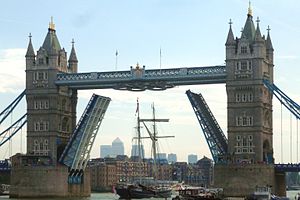
Road
Tower Bridge is still a busy crossing of the Thames: it is crossed by over 40,000 people (motorists, cyclists and pedestrians) every day.[14] The bridge is on the London Inner Ring Road, and is on the eastern boundary of the London congestion charge zone. (Drivers do not incur a charge by crossing the bridge.)
To maintain the integrity of the structure, the City of London Corporation has imposed a 20 mph speed restriction, and an 18-tonne weight limit on vehicles using the bridge. A camera system measures the speed of traffic crossing the bridge, using a number-plate-recognition system to send fixed penalty charges to speeding drivers.[27]
A second system monitors other vehicle parameters. Induction loops and piezoelectric sensors are used to measure the weight, the height of the chassis above ground level, and the number of axles of each vehicle.[27]
River
The bascules are raised around 1,000 times a year.[28] River traffic is now much reduced, but it still takes priority over road traffic. Today, 24 hours' notice is required before opening the bridge, and opening times are published in advance on the bridge's website.[29] There is no charge for vessels.
When needing to be raised for the passage of a vessel, the bascules are only raised to an angle sufficient for the vessel to safely pass under the bridge, except in the case of a vessel with the Monarch on board in which case they are raised fully no matter the size of the vessel.
Tower Bridge Exhibition
The Tower Bridge Exhibition is a display housed in the bridge's twin towers, the high-level walkways and the Victorian engine rooms. It uses films, photos and interactive displays to explain why and how Tower Bridge was built. Visitors can access the original steam engines that once powered the bridge bascules, housed in a building close to the south end of the bridge.[13]
The exhibition charges an admission fee. Entrance is from the west side of the bridge deck to the northern tower, from where visitors ascend to level 4 by lift before crossing the high-level walkways to the southern tower. In the towers and walkways is an exhibition on the history of the bridge. The walkways also provide views over the city, the Tower of London and the Pool of London, and include a glass-floored section. From the south tower, visitors can visit the engine rooms, with the original steam engines, which are situated in a separate building beside the southern approach to the bridge.[30]
Reaction
Although the bridge is an undoubted landmark, professional commentators in the early 20th century were critical of its aesthetics. "It represents the vice of tawdriness and pretentiousness, and of falsification of the actual facts of the structure", wrote Henry Heathcote Statham,[31] while Frank Brangwyn stated that "A more absurd structure than the Tower Bridge was never thrown across a strategic river".[32]
Architectural historian Dan Cruickshank selected the bridge as one of his four choices for the 2002 BBC television documentary series Britain's Best Buildings.[33]
Tower Bridge is often mistaken for London Bridge,[34] the next bridge upstream. A popular urban legend is that in 1968, Robert P. McCulloch, the purchaser of the old London Bridge that was later shipped to Lake Havasu City in Arizona, believed that he was in fact buying Tower Bridge. This was denied by McCulloch himself and has been debunked by Ivan Luckin, the vendor of the bridge.[35]
A partial replica of Tower Bridge has been built in the town of Suzhou in China. The replica differs from the original in having no lifting mechanism and having four separate towers.[36]
Outside links
| ("Wikimedia Commons" has material about Tower Bridge) |
- Official Tower Bridge Exhibition website
- Bridge Lift Times
- Winchester, Clarence, ed (1938). "Building the Tower Bridge". Wonders of World Engineering. London: Amalgamated Press. pp. 575–580. http://wondersofworldengineering.com/tower-bridge.html. Describes the construction of Tower Bridge
References
Citations
- ↑ 1.0 1.1 "Tower Bridge restored to true colours | Tower Bridge". http://www.thetowerbridge.info/diary/tower-bridge-restored-to-true-colours.html. Retrieved 8 February 2017.
- ↑ 2.0 2.1 "Finishing touches to Tower Bridge | Tower Bridge". http://www.thetowerbridge.info/diary/finishing-touches-to-tower-bridge.html. Retrieved 8 February 2017.
- ↑ "Tower Bridge Exhibition website". Corporation of The City of London. http://www.towerbridge.org.uk/TBE/EN/Exhibition/. Retrieved 18 November 2010.
- ↑ 4.0 4.1 4.2 Weinreb et al. 2008, p. 922.
- ↑ 5.0 5.1 5.2 5.3 Roberts, Chris, "Cross River Traffic", Granta, 2005
- ↑ The Times, 2 July 1894
- ↑ 7.0 7.1 7.2 7.3 7.4 7.5 7.6 "Tower Bridge". Archive – the Quarterly Journal for British Industrial and Transport History (Lightmoor Press) (3): 47. 1994. SSN 1352-7991.
- ↑ John Eade (22 July 1976). "Where Thames Smooth Waters Glide". Thames.me.uk. http://thames.me.uk/s00040.htm. Retrieved 13 June 2012.
- ↑ Smith, Denis (2001). Civil Engineering Heritage: London and the Thames Valley. Thomas Telford. pp. 22–23. ISBN 0-7277-2876-8.
- ↑ "The Tower Bridge Engine". Forncett Industrial Steam Museum. http://oldenginehouse.users.btopenworld.com/towerb.htm. Retrieved 27 February 2007.
- ↑ 11.0 11.1 "The Firm: BHA Cromwell House". G. M. Beresford Hartwell. http://www.arbitrator-engineer-gbh.co.uk/#!firm/c1n8o. Retrieved 30 June 2015.
- ↑ 12.0 12.1 Hartwell, Geoffrey. "Tower Bridge, London". http://www.hartwell.pwp.blueyonder.co.uk/tbpic.htm. Retrieved 27 February 2007.
- ↑ 13.0 13.1 "About Us". Tower Bridge Exhibition. http://www.towerbridge.org.uk/about/. Retrieved 14 July 2015.
- ↑ 14.0 14.1 "Fix to stop bridge getting stuck". BBC News. 17 January 2006. http://news.bbc.co.uk/1/hi/england/london/4620622.stm. Retrieved 25 September 2007.
- ↑ "Tower Bridge to get £4m facelift". BBC News. 7 April 2008. http://news.bbc.co.uk/1/hi/england/london/7335380.stm. Retrieved 8 April 2008.
- ↑ "Tower Bridge lighting". Interior Event & Exhibition Lighting Design scheme. ES Lighting Design. 29 April 2009. http://www.eslightingdesign.co.uk/commercial/london-tower-bridge.aspx. Retrieved 27 August 2009.
- ↑ "Tower Bridge restored to true colours". Tower Bridge Restoration Website. 10 March 2010. http://www.thetowerbridge.info/diary/tower-bridge-restored-to-true-colours. Retrieved 24 May 2010.
- ↑ Olympics rings Tower over London, Daily Mail (London), accessed 29 July 2012.
- ↑ "Tower Bridge is London's Latest Venue – Classic FM Music News and Features". Classicfm.com. http://www.classicfm.com/music-news/latest-news/tower-bridge-londons-latest-venue/. Retrieved 28 May 2013.
- ↑ "Tower Bridge as a musical instrument". Classical-Music.com. http://www.classical-music.com/news/tower-bridge-musical-instrument. Retrieved 28 May 2013.
- ↑ Topping, Alexandra (13 August 2012). "London 2012: let the Paralympics preparations begin". The Guardian (London). https://www.theguardian.com/sport/2012/aug/13/london-2012-paralympic-preparations-begin?newsfeed=true. Retrieved 18 August 2012.
- ↑ "11 Secret Features Of Famous London Landmarks". Londonist. 20 October 2015. http://londonist.com/2015/10/hiding-in-plain-site#gallery=2133548,2133553.
- ↑ "Bridge History". Towerbridge.org.uk. 1 February 2003. http://www.towerbridge.org.uk/TBE/EN/BridgeHistory/. Retrieved 13 June 2012.
- ↑ Lane, MR (1989). The Rendel Connection: a dynasty of engineers. Quiller press, London. ISBN 1-870948-01-7.
- ↑ "History William Sugg & Co Westminster gas lighting cooking heating appliance manufacturer.". http://www.williamsugghistory.co.uk.
- ↑ Fleet | Sail Royal Greenwich
- ↑ 27.0 27.1 Speed Check Services. "Bridge Protection Scheme" (PDF). http://www.speedcheck.co.uk/images/Tower_Bridge_Case_Study.pdf. Retrieved 18 November 2010.
- ↑ "Bridge Lifts". Tower Bridge Official Website. Archived from the original on 12 September 2007. https://web.archive.org/web/20070912190426/http://www.towerbridge.org.uk/TowerBridge/English/BridgeLifts/. Retrieved 25 September 2007.
- ↑ "Bridge Lift Times". City of London. http://www.towerbridge.org.uk/lift-times/. Retrieved 10 November 2014.
- ↑ "Step Inside". Tower Bridge Exhibition. http://www.towerbridge.org.uk/step-inside/. Retrieved 14 July 2015.
- ↑ Statham, H.H., "Bridge Engineering", Wiley, 1916.
- ↑ Brangwyn, F., and Sparrow, W. S., "A Book of Bridges", John Lane, 1920.
- ↑ Cruickshank, Dan. "Choosing Britain's Best Buildings". BBC History. http://www.bbc.co.uk/history/programmes/programme_archive/best_buildings_06.shtml. Retrieved 3 June 2008.
- ↑ Jason Cochran, Pauline Frommer (2007). Pauline Frommer's London. Frommer's. p. 184. ISBN 978-0-470-05228-0. https://books.google.com/books?id=kIrim0i-VKoC&pg=PA184. Retrieved 9 July 2011.
- ↑ "How London Bridge was sold to the States (From This Is Local London)". Thisislocallondon.co.uk. http://www.thisislocallondon.co.uk/news/169982.how_london_bridge_was_sold_to_the_states/. Retrieved 13 June 2012.
- ↑ Silk, Michael; Manley, Andrew (3 June 2014). "From Tower Bridge to Sydney Harbour, welcome to China’s city of clones". The Guardian. https://www.theguardian.com/cities/2014/jun/03/from-tower-bridge-to-sydney-harbour-welcome-to-chinas-city-of-clones. Retrieved 14 July 2015.
Sources
- Hibbert, Christopher, Weinreb, Ben and Keay, Julia; The London Encyclopaedia; ISBN 978-1-405-04924-5
| Bridges and crossings on the River Thames | ||||||
|---|---|---|---|---|---|---|
| Southwark Bridge | Cannon Street Railway Bridge | London Bridge | Tower Bridge | Rotherhithe Tunnels | Greenwich Foot Tunnel | Jubilee Line tunnels |
